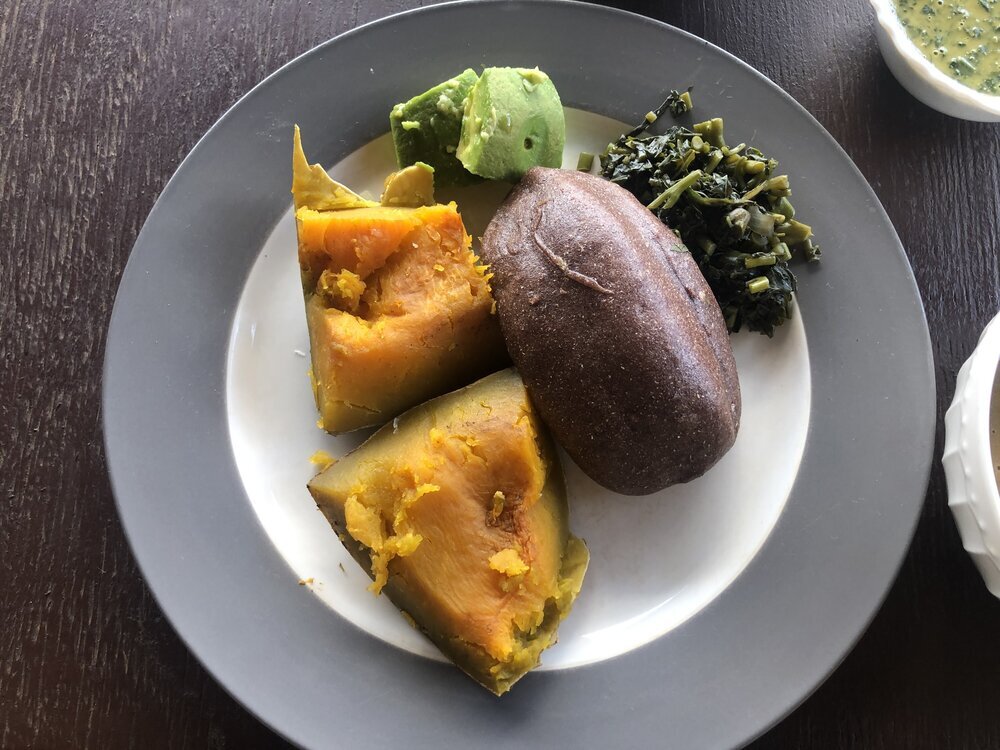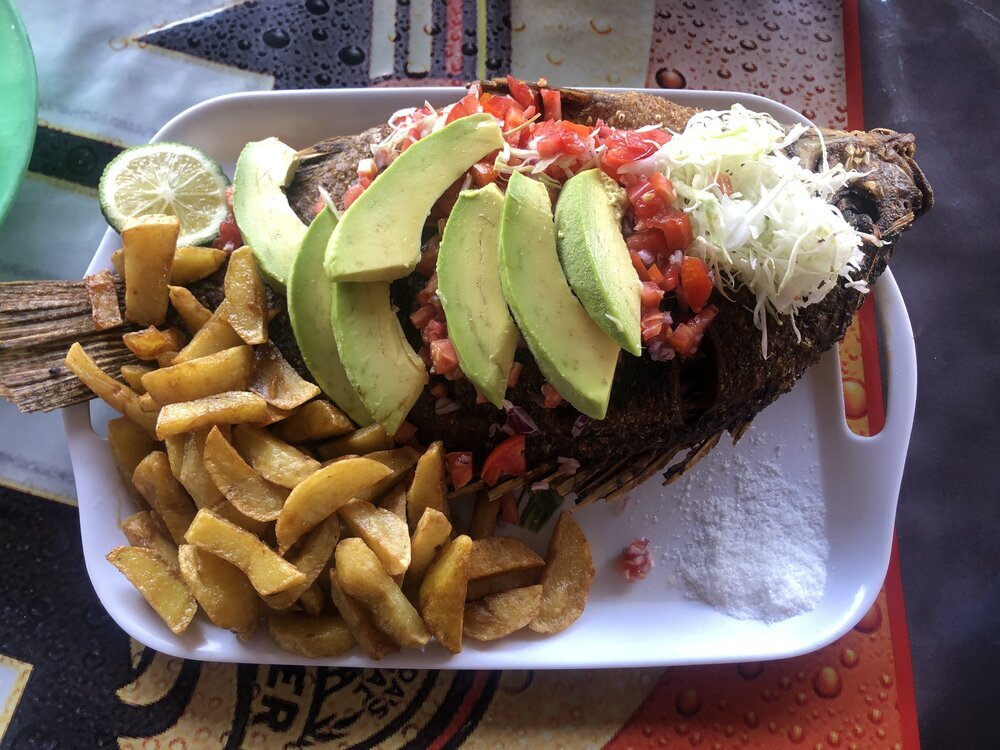What’s on your plate? - Afro-diasporic cuisines that transcend boundaries and build community
Taking a moment at a market square after spending the day practicing Swahili with my teacher - Gaba landing site, shores of lake Victoria
Growing up in Harlem, I spent most of my Saturday afternoons running food errands with my mother. Our daily meals were hearty, with stews and soups filled with assorted meat and fish that are rarely found in a traditional American grocery store. So, on Saturday afternoons, we would venture beyond the Yankee stadium straight to the Grand Concourse in the Bronx, where our favorite African market is located. The Bronx houses the largest enclave of Ghanaian immigrants in New York City, and on a typical day, you could hear residents responding to greetings in “Twi”, a popular African dialect from Ghana. It was obvious that many people on this side of town knew each other, even if it was not on a personal level. The Grand Concourse and the side streets that connect with it, is packed with barber shops blasting Ghanaian Highlife music from the 90s. Many of the convenient shops in the area double down as Western Union centers, where people queue in long lines to send money to family back home. Upon arrival at the market, we are immediately greeted by the pungent smell of smoked fish and salted tilapia as we walk in. I would trail behind my mother as we perused through aisles of imported goods carefully dated and labelled with international seals of approval. My mother would fill our shopping cart to the brim, nodding approvingly at words like, “organic”, and “FDA certified” as she read the labels. Before leaving the market, she would inquire about the latest gossip in the community; she’d pick up flyers announcing upcoming gospel festivals or funeral ceremonies of which she never attended. I knew for a fact that my mother valued our trips to the African market; I did too. The African market created a migrant space of belonging by trans-localizing Ghanaian life in New York. The space itself houses cultures and traditions, and the people who engage in it carry with them invaluable stories of strife, resilience, passion, determination and hope.
As I grew older and began to travel abroad for school, research and work, among other things, food remained central to my experiences. My most recent undertaking uncovered Afro-Diasporic communities in Latin America. With a population of almost 5 million people of African descent, Colombia seemed like a good starting point to learn about how food manifests symbolic and even transformative connotations in Afro-Diasporic communities. For several months, I read about the small town of Palenque and its people. La Palenque de San Basillo, popularly known as “ Palenque”, is a settlement of about 4,000 people. It was founded by Benkos Bioho, a former African King who fled the system of slavery to build a community for people like him. I found a really cheap flight deal from NYC to Cartagena that I could not refuse. I planned the trip of my life.
Colombia is a popular destination for cuisine bursting with flavor, and the people of Palenque have managed to preserve their African heritage through strong internal networks and food. Upon arrival in Cartagena, I met with Jason, a young Afro-Colombian missionary born and raised in Palenque. Jason and I met through my translator, Annette, who was then a student at Columbia University in New York. We crammed into the back of a taxi, driving through small towns and enduring occasional bumps and potholes along the road. On our journey, I thought about the colorful Palenqueras we met in Cartagena’s historic old town a few days prior. Palenqueras are black women in colorful dresses expertly balancing bowls of fruit on their heads. They have become a staple tourist attraction in the city as they make money selling food and posing with tourists in well documented Instagram photos. I imagined their journey traveling this road on a daily basis and wished I had tipped the women I met a little more after posing for a photo myself. After an hour, we finally arrived at the main entrance and were immediately greeted by men who knew Jason. They welcomed us with open arms, sharing their love for the African continent and their dreams to hopefully visit someday. They said they supported Ghana, and many other African countries during the 2008 FIFA world cup. I felt at home.
A picture of me and two palenqueras in Cartegena, Colombia
As we drove through the community, Jason pointed out historic buildings and structures, adding that despite the lack of financial resources, the people of Palenque were very proud of their African roots and they expressed them in a number of ways. They preserved every aspect of their culture, especially through food.
We met our host, Mama, who immediately put us to work in the kitchen. I was responsible for juicing blocks of coconut, while Mama and her oldest daughter cleaned fresh tilapia and fried plantain. Mama talked us through her cooking as she carefully diced onions, ginger, and peppers. She tossed pieces of corn, and other vegetables into her soup. I thought about the cultural identity of her recipe: its travel across oceans and its transformation and modification along the way, and finally settling in Palenque. I found similarities between Mama’s soup and my mother’s tilapia soup from Ghana. The only missing ingredients were okra and a little bit more scotch bonnet! Both recipes were strikingly similar, and after the first taste, I felt at home. At dinner, I listened carefully as Mama shared stories about her missionary work in different parts of the world, including the African continent. She drew parallels between food practices in Palenque and other African nations and went over food rituals for special occasions like funerals and wedding ceremonies. In the few days that I spent there, I made culinary connections to my Ghanaian heritage. I thought through food crops such as maize and culinary habits that may have travelled to the western hemisphere during the Trans-Atlantic Slave trade, and smiled through stories of resilience and hope as I met with elders in the community. My visit to Palenque left an indelible memory and I couldn’t wait to share my experiences with my friends and family back in New York. Fast forward to today, I am back on the African continent, the origin of food, tastes and scents I found in African markets in New York and Palenque.
Food is abundant in Uganda and now that I am here, I am learning more about food networks and accessibility in cities like Kampala. African women, for the most part, control the growing, preparation and conservation of food, and in market spaces in Kampala, women are the gateway to nutritious living.
Me holding grilled plantain, popularly known as “Gonja” in Kampala while purchasing a rack of bananas
I have met and interacted with Ugandan women who have migrated from different parts of the country to Kampala for better opportunities for themselves and their families. In markets like Nakasero, women join small community groups and create support networks where they look out for each other. They support funeral ceremonies and stand in as guarantors when a member is in need of a loan. This network of market women is built on trust as well as their common interests. In this market space, you will find tables of tomatoes carefully arranged in symmetry, branches of bananas and plantains in different sizes and colors and leafy green vegetables that are sometimes indistinguishable. You will also find a line of women sitting shoulder to shoulder hustling to sell their goods. Their type of competition is nestled in the spirit of trust, sisterhood and community. Honoring the spirit of community, I hosted a Friendsgiving dinner about a week ago in my apartment in Kampala.
The dinner featured food from the East and West of Africa, as well as the Caribbean. Friends from Uganda prepared local dishes like Matoke (crushed bananas), Chapati and peanut sauce. We served the popular “posho” and “ugali” from Kenya, curry goat from Jamaica and I dished out my favorite beef stew, a spicy yet flavorful blend of ginger, basil, cloves, tomatoes, scotch bonnet and other spices. My dining room was filled with new cultures and different flavors from the coast of West Africa to the shores of the Caribbean. In fact, the gathering reminded me of my time in Marrakesh, Morocco, where I shared a delectable meal with a group of Senegalese immigrants a few minutes away from the city center. Goumba, whom I met while exploring the city, invited me to break fast with him and his friends during the month of Ramadam. He prepared a mouthwatering Thieboudinne, a traditional Senegalese dish, and waltzed out of his kitchen with a big plate of steaming rice, vegetables and fish and set it onto the table. (see video of us enjoying dinner below) To this day, I still beat myself for not honoring Goumba’s second dinner invitation the night before leaving Marrakesh. In the short time that I spent with Goumba, I learned so much about his ambitious goals and beautiful dreams and we connected on our shared determination to travel the entire African continent, one city at a time.
Back in my living room in Kampala, I was happy to have met and connected with folks who valued food and intimate conversation as much as I did. We shared various food practices throughout the African continent and analyzed the importance of economic stability for Africa’s growth. Some of us shared our mutual confusion over the different types of bananas in Uganda (there are several!). As expected, the West Africans in the group broke into a fiery debate on who cooks jollof rice the best. I stole glances at my new friends who passionately expressed their love and admiration for the African continent and was very proud to have brought together a community of food loving intellectuals.
Moments like these reminded me of my mother and I waltzing through aisle of pungent smells and spices at the African market in the Bronx, and engaging in conversations with fellow shoppers and shop keepers who had travelled far and wide to replenish their kitchen cabinets and stalls. Their stories embedded in every spice, corn husk and or goat meat found on the store counters. These stories provided a window into the experiences of migrants throughout the city, and in them, we learned how they skillfully balanced the delicate act of preserving culture, and on the other, adapting to the norms of the new world.










